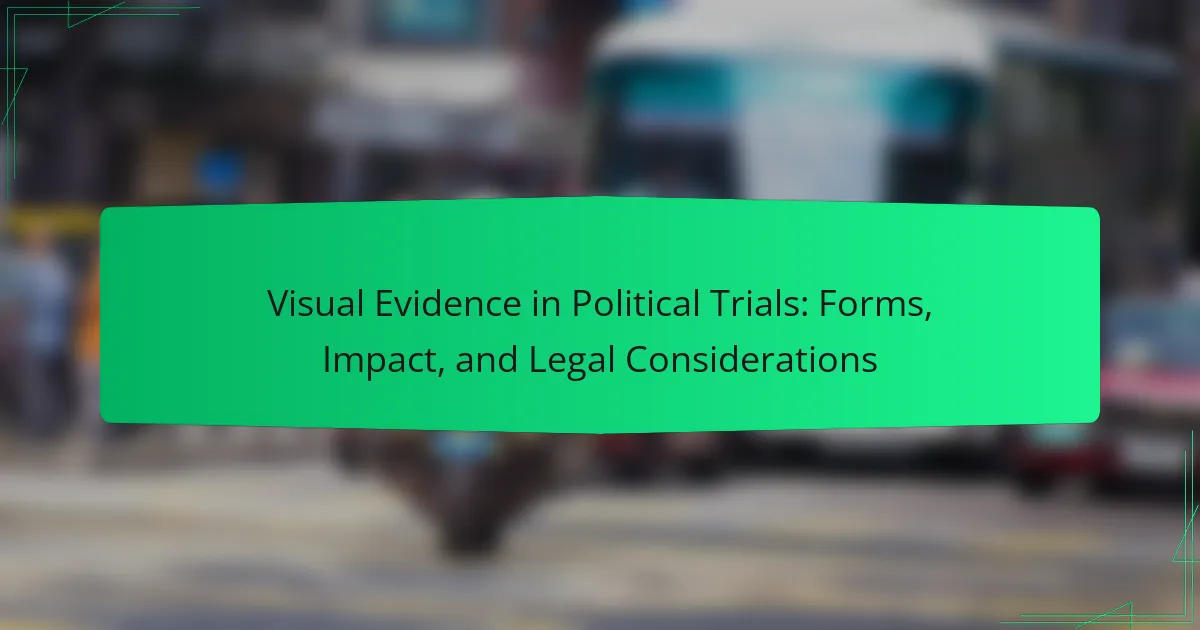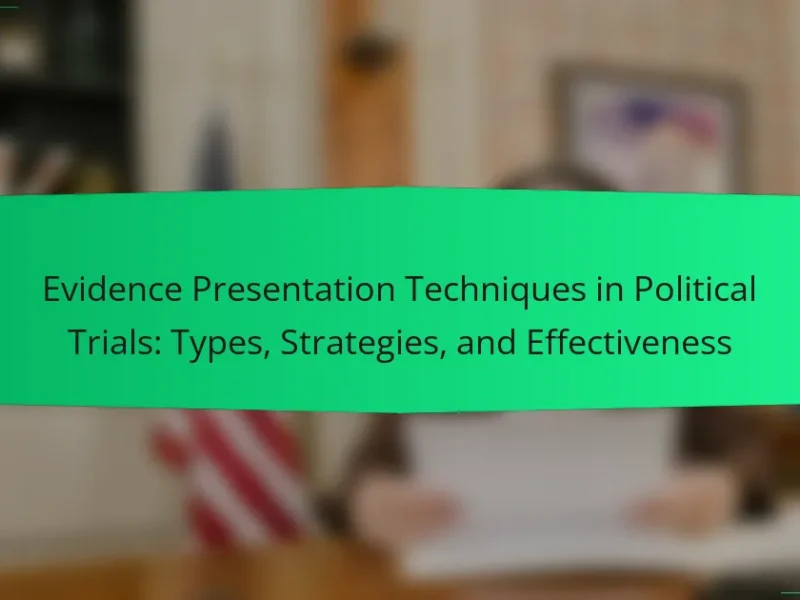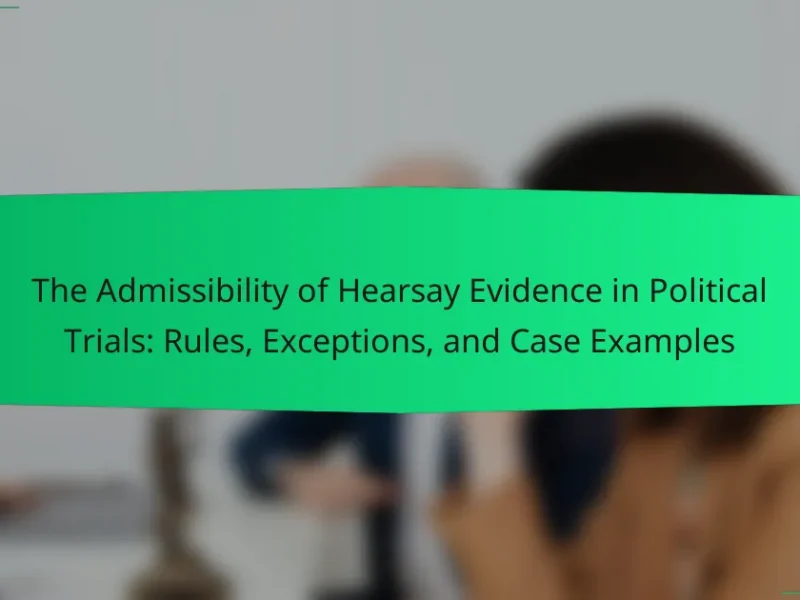Visual evidence in political trials encompasses various forms of materials, including photographs, videos, diagrams, and charts, used to support or challenge claims in court. This evidence is crucial for illustrating facts, providing context, and enhancing jurors’ understanding of complex situations. The article explores the significant impact of visual evidence on jurors’ perceptions and memory retention compared to verbal testimony. Additionally, it addresses the legal considerations surrounding visual evidence, such as authenticity, relevance, admissibility, and potential privacy concerns. Overall, visual evidence serves as a powerful tool in the legal process of political trials, influencing case outcomes and jury decisions.
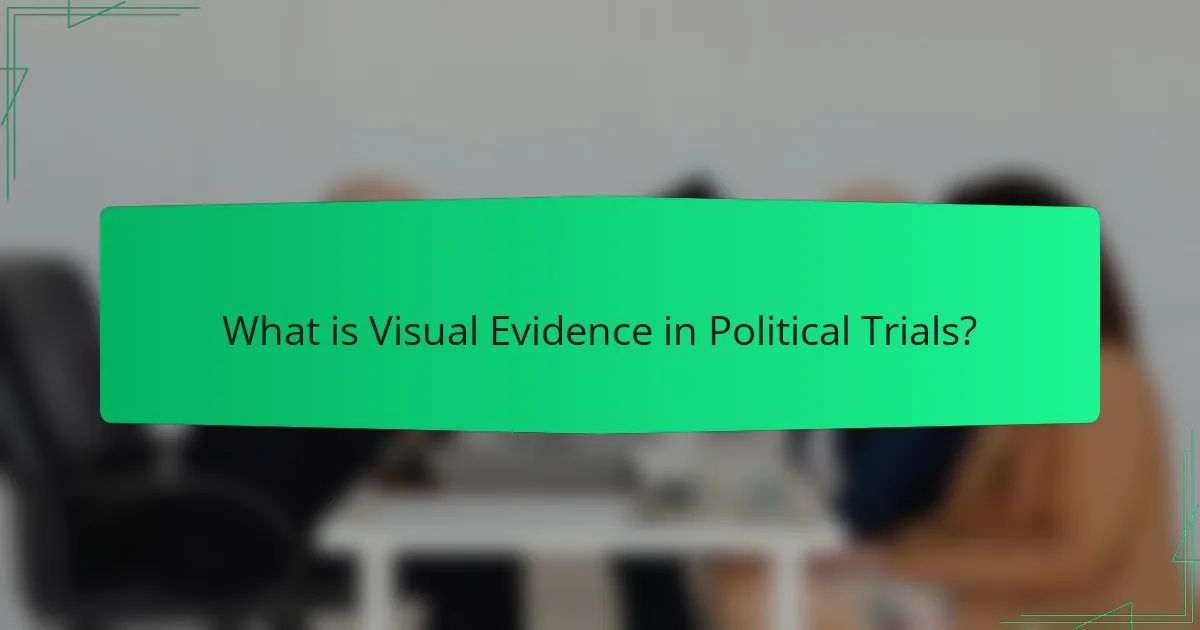
What is Visual Evidence in Political Trials?
Visual evidence in political trials refers to any visual material used to support or refute claims in court. This can include photographs, videos, and diagrams. Such evidence plays a crucial role in illustrating facts and providing context. It helps jurors understand complex situations more clearly. The use of visual evidence can significantly impact the jury’s perception. Studies show that jurors are more likely to remember visual information than verbal testimony. Additionally, visual evidence can enhance the credibility of a case. It serves to corroborate witness statements and other forms of evidence. Overall, visual evidence is a powerful tool in the legal process of political trials.
How is visual evidence defined in the context of political trials?
Visual evidence in political trials is defined as any graphical representation used to support or contest claims during legal proceedings. This includes photographs, videos, and diagrams that provide context or substantiate arguments. Such evidence plays a critical role in illustrating events or actions relevant to the case. It can influence jury perceptions and judicial decisions significantly. Courts often evaluate the authenticity and relevance of visual evidence before admission. For instance, the use of video footage in political trials has been pivotal in cases involving public figures. This underscores the evolving nature of evidence in the legal system.
What are the different types of visual evidence used in political trials?
Visual evidence in political trials includes photographs, videos, diagrams, charts, and maps. Photographs can capture key moments or evidence, such as protests or political events. Videos may provide real-time footage of incidents or testimonies. Diagrams often illustrate complex scenarios or relationships. Charts can present statistical data relevant to the case. Maps may show locations of events or movements. Each type serves to clarify facts and support arguments in legal proceedings.
How does visual evidence differ from other forms of evidence?
Visual evidence differs from other forms of evidence in its ability to convey information through images or videos. Unlike textual evidence, visual evidence can provide immediate context and emotional impact. This form of evidence often aids in the comprehension of complex scenarios. Visual evidence can also be more persuasive in a courtroom setting. Studies show that juries may respond more favorably to visual evidence compared to purely verbal testimonies. Furthermore, visual evidence can capture nuances that written descriptions may miss. It offers a direct representation of events, making it a powerful tool in legal proceedings.
Why is visual evidence significant in political trials?
Visual evidence is significant in political trials because it provides tangible proof that can influence jurors’ perceptions. This type of evidence can include photographs, videos, and diagrams that illustrate key events or actions. Visual evidence often aids in clarifying complex narratives that may be difficult to convey through verbal testimony alone. Studies have shown that jurors are more likely to remember and be persuaded by visual information compared to verbal accounts. For instance, a study published in the Journal of Legal Studies found that jurors exposed to visual evidence were 20% more likely to reach a favorable verdict for the presenting party. Additionally, visual evidence can evoke emotional responses, making it a powerful tool in swaying opinions during trials.
What impact does visual evidence have on jury perceptions?
Visual evidence significantly influences jury perceptions. It enhances the jurors’ understanding of the case. Visuals can evoke emotional responses that affect decision-making. Research shows that jurors are more likely to remember information presented visually. A study by the National Center for State Courts found that jurors found visual evidence more persuasive than verbal testimony. Visuals can clarify complex information, making it easier for jurors to follow. They can also create a stronger connection to the case, impacting the jury’s overall judgment. The presence of visual evidence often leads to increased engagement during trials.
How can visual evidence influence the outcome of a political trial?
Visual evidence can significantly influence the outcome of a political trial. It serves as a powerful tool for persuasion and clarity. Jurors often respond more strongly to visual stimuli than to verbal testimony alone. High-quality images or videos can provide clear context and enhance understanding of complex situations. For instance, in the trial of former President Bill Clinton, video footage played a crucial role in shaping public perception. Studies have shown that jurors are more likely to remember visual evidence compared to spoken words. This retention can lead to stronger emotional responses, impacting verdicts. Thus, visual evidence can be pivotal in swaying opinions and determining outcomes in political trials.
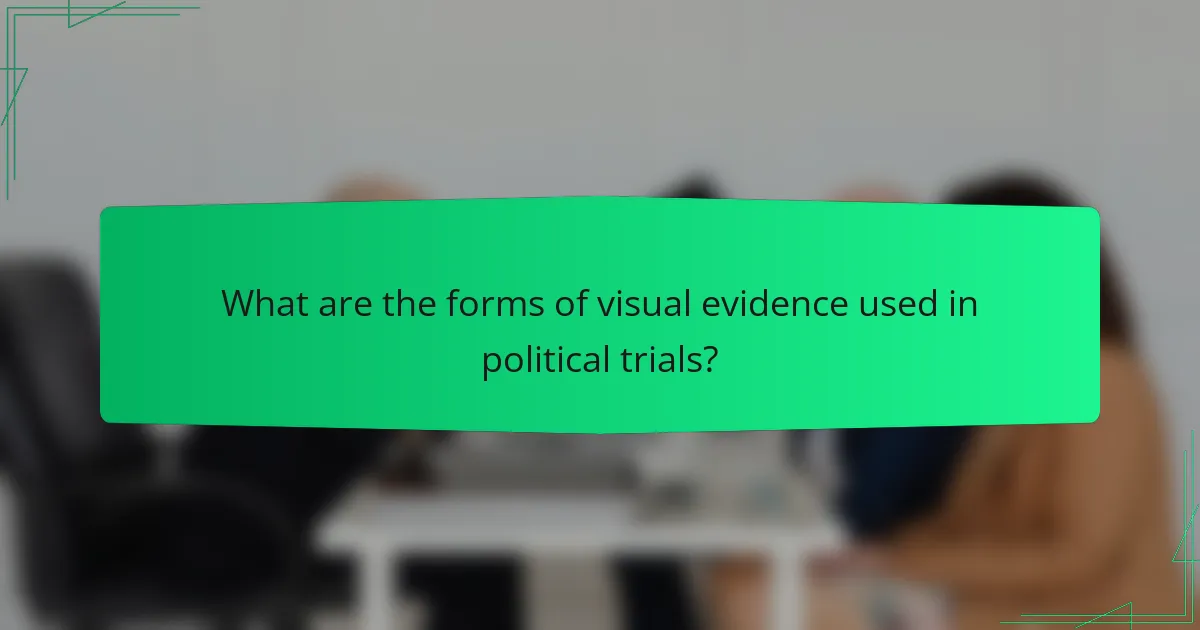
What are the forms of visual evidence used in political trials?
Visual evidence in political trials includes photographs, videos, diagrams, and charts. Photographs can capture events or scenes relevant to the trial. Videos may provide real-time footage of incidents or testimonies. Diagrams often illustrate complex scenarios or relationships between entities involved. Charts can present statistical data or trends pertinent to the case. Each form serves to enhance understanding and support arguments. These visual aids can significantly impact jurors’ perceptions and decisions.
What types of visual evidence are commonly presented in court?
Photographs, diagrams, and videos are the primary types of visual evidence commonly presented in court. Photographs can capture crime scenes, injuries, and relevant locations. Diagrams help illustrate the layout of a scene or the relationship between objects. Videos can provide real-time accounts of events or actions. Additionally, charts and graphs may be used to present statistical data effectively. Each type of visual evidence serves to clarify the facts of a case. They enhance understanding and retention of complex information for juries. These forms of evidence are admissible under rules of evidence, ensuring they meet legal standards for relevance and reliability.
How are photographs utilized as visual evidence in political trials?
Photographs are utilized as visual evidence in political trials to support claims and establish facts. They provide a tangible representation of events, locations, or individuals involved in the case. Photographs can capture moments that are critical to understanding the context of the trial. They serve as a visual record that can corroborate witness testimonies or contradict opposing evidence. Courts often assess the authenticity and relevance of photographs before admitting them as evidence. Properly authenticated photographs can enhance the persuasiveness of an argument presented by legal teams. For instance, images from protests can illustrate the scale of events and the presence of key figures. This utilization of photographs is governed by legal standards that ensure their integrity and reliability in judicial proceedings.
What role do videos play in presenting visual evidence?
Videos serve as a powerful medium for presenting visual evidence in political trials. They provide a dynamic and engaging way to convey information. Videos can capture real-time events, offering context that static images or text may lack. This immediacy can enhance the emotional impact on juries and judges. Studies show that jurors are more likely to be persuaded by evidence presented in video format. For instance, a 2018 study published in the Journal of Legal Studies found that video evidence significantly influenced juror decision-making. Furthermore, videos can illustrate complex scenarios clearly, making them accessible to a wider audience. They also allow for the presentation of evidence in a more relatable manner, which can aid in understanding the nuances of a case. Overall, videos play a crucial role in enhancing the effectiveness and clarity of visual evidence in political trials.
How is digital evidence categorized in political trials?
Digital evidence in political trials is categorized into three main types: electronic documents, digital communications, and multimedia evidence. Electronic documents include emails, reports, and digital files that can be analyzed for authenticity and relevance. Digital communications encompass text messages, social media posts, and online interactions that can provide insights into intent and conspiracy. Multimedia evidence consists of images, videos, and audio recordings that may capture events or statements pertinent to the trial. Each category plays a crucial role in establishing facts and supporting legal arguments in political trials.
What are the challenges of using digital visual evidence?
Digital visual evidence presents several challenges. One major challenge is authenticity verification. Digital images and videos can be easily manipulated, raising doubts about their reliability. Another challenge is the potential for misinterpretation. Viewers may misjudge context or intent, leading to skewed narratives. Privacy concerns also arise when using visual evidence, particularly in sensitive political contexts. Legal admissibility is a further challenge, as courts may have stringent rules regarding digital evidence. Additionally, the sheer volume of digital evidence can overwhelm legal teams, complicating the review process. Finally, technological disparities may hinder access to evidence for some parties involved in legal proceedings.
How does the authenticity of digital evidence affect its admissibility?
The authenticity of digital evidence significantly affects its admissibility in court. Courts require that digital evidence is proven to be genuine and not tampered with. Authenticity establishes that the evidence accurately represents what it claims to depict. Without proper authentication, digital evidence may be deemed unreliable and inadmissible. Legal standards, such as the Federal Rules of Evidence, mandate that parties must demonstrate the authenticity of evidence. This often involves expert testimony or digital forensics to verify the source and integrity of the evidence. In cases where authenticity is disputed, judges may exclude the evidence from proceedings. Thus, the authenticity of digital evidence is crucial for its acceptance in legal contexts.
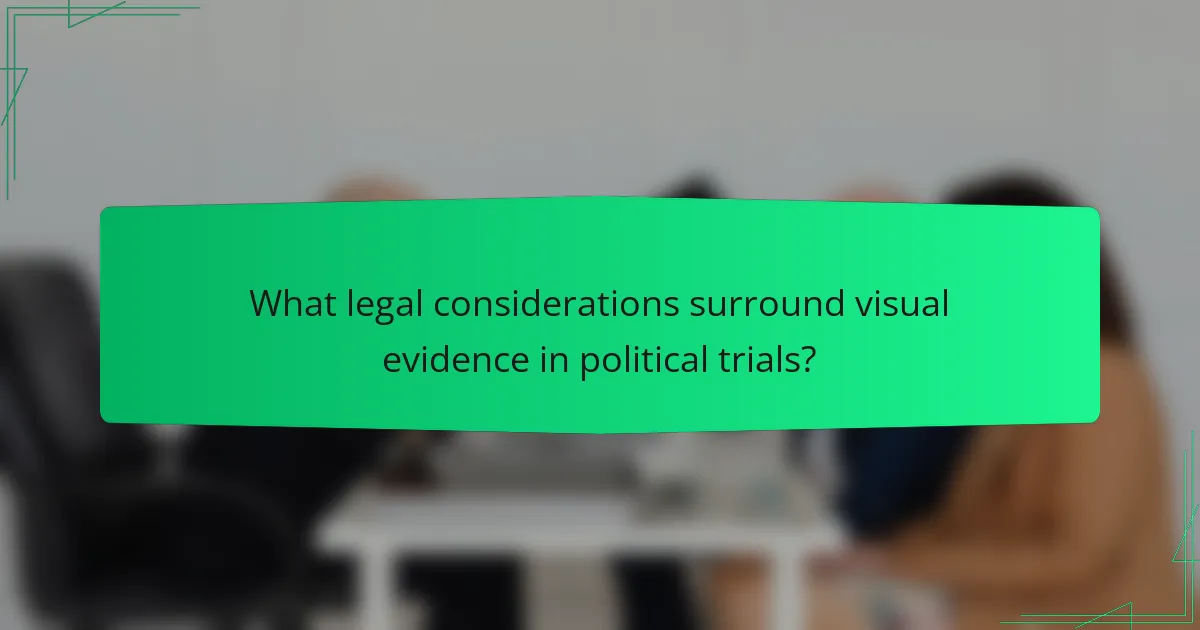
What legal considerations surround visual evidence in political trials?
Legal considerations surrounding visual evidence in political trials include authenticity, relevance, and admissibility. Courts require visual evidence to be authentic, meaning it must be proven to be genuine and not altered. The relevance of visual evidence is critical; it must directly relate to the case at hand. Admissibility is governed by rules such as the Federal Rules of Evidence in the U.S., which outline criteria for what constitutes acceptable evidence. Additionally, privacy concerns may arise if the visual evidence involves individuals who did not consent to being recorded. Courts also consider the potential for prejudice, ensuring that the visual evidence does not unfairly sway the jury. The use of visual evidence must comply with legal standards to ensure a fair trial.
What are the rules governing the admissibility of visual evidence?
The rules governing the admissibility of visual evidence are primarily based on relevance, authenticity, and reliability. Visual evidence must be relevant to the case at hand. This means it should help to prove or disprove an element of the case. Authenticity requires that the evidence be proven to be what it claims to be. This often involves establishing the chain of custody. Reliability pertains to the evidence’s ability to accurately represent what it depicts. Courts may also consider whether the evidence is prejudicial versus probative. Additionally, visual evidence must comply with legal standards set forth in rules such as the Federal Rules of Evidence. These rules ensure that visual evidence contributes meaningfully to the judicial process.
How do courts determine the relevance of visual evidence?
Courts determine the relevance of visual evidence by assessing its connection to the case. The evidence must support or contradict a fact that is at issue in the trial. Judges apply the standard of relevance outlined in the Federal Rules of Evidence, specifically Rule 401. This rule states that evidence is relevant if it makes a fact more or less probable than it would be without the evidence. Additionally, courts consider whether the probative value of the visual evidence outweighs any potential prejudicial effect. This evaluation ensures that the evidence contributes meaningfully to the case rather than causing unfair bias. Courts may also rely on precedents to guide their decisions regarding the admissibility of visual evidence in specific contexts.
What challenges do attorneys face when presenting visual evidence?
Attorneys face several challenges when presenting visual evidence. One major challenge is ensuring the evidence is admissible in court. Courts have strict rules regarding the authenticity and relevance of visual materials. Another challenge is the potential for misinterpretation by jurors. Jurors may perceive visual evidence differently than intended. Additionally, attorneys must consider the technical quality of the visuals. Poor quality can undermine the credibility of the evidence.
Moreover, attorneys must effectively integrate visual evidence into their arguments. This requires strategic planning and clear presentation. Finally, there may be emotional responses from jurors to certain images. These responses can influence their decision-making process.
How does visual evidence intersect with legal ethics in political trials?
Visual evidence intersects with legal ethics in political trials by influencing perceptions of justice and fairness. The use of visual evidence must adhere to ethical standards to ensure it is not misleading. Ethical guidelines require that visual evidence be authentic, relevant, and properly contextualized. Misrepresentation of visual evidence can lead to unjust outcomes and undermine public trust in the legal system. Courts often evaluate the admissibility of visual evidence based on its integrity and the potential for bias. Ethical considerations also include the privacy rights of individuals depicted in visual evidence. The balance between transparency and ethical obligations is crucial in political trials. Adherence to these ethical standards promotes accountability and upholds the rule of law.
What ethical considerations must lawyers keep in mind when using visual evidence?
Lawyers must consider accuracy, relevance, and consent when using visual evidence. Accuracy ensures that the visual evidence is truthful and not misleading. Relevance means the evidence must directly relate to the case at hand. Consent is crucial when using images or videos of individuals, as unauthorized use can violate privacy rights. Additionally, lawyers should avoid presenting evidence that could cause undue prejudice or emotional bias in the courtroom. Ethical guidelines from organizations like the American Bar Association emphasize these considerations. Violating these principles can lead to legal repercussions and damage to a lawyer’s reputation.
How can misuse of visual evidence impact a trial’s integrity?
Misuse of visual evidence can severely compromise a trial’s integrity. When visual evidence is manipulated, it can mislead juries and judges. This distortion can result in wrongful convictions or acquittals. For instance, altered images can create false narratives. The legal system relies on accurate evidence for justice. Misrepresentation undermines trust in the judicial process. Historical cases show that flawed visual evidence led to significant legal errors. Inaccurate visual evidence can also prolong trials and increase costs. Overall, integrity in trials hinges on the authenticity of all evidence presented.
What best practices should be followed when presenting visual evidence in political trials?
Best practices for presenting visual evidence in political trials include ensuring clarity and relevance. Visuals must be directly related to the case at hand. They should be easy to understand for the jury and judge. High-quality images or videos are essential to avoid misinterpretation. Proper authentication of visual evidence is crucial to establish credibility. Presenters must explain the context of each visual clearly. Timing of visual presentation should align with the narrative of the trial. Legal guidelines must be followed to ensure admissibility. These practices enhance the effectiveness of visual evidence in influencing trial outcomes.
Visual evidence in political trials encompasses various forms of graphical materials, such as photographs, videos, diagrams, and charts, used to support or contest claims within legal proceedings. This article explores the significance of visual evidence, detailing its impact on jury perceptions and the overall outcome of trials. It also examines the legal considerations surrounding the admissibility of visual evidence, including authenticity and relevance, as well as the ethical implications for legal practitioners. By understanding the role and challenges of visual evidence, readers can appreciate its critical function in shaping judicial processes and enhancing the clarity of complex narratives in political trials.
